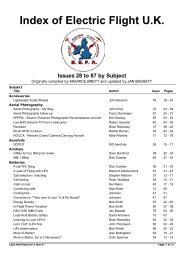ELECTRIC FLIGHT U.K. - British Electric Flight Association
ELECTRIC FLIGHT U.K. - British Electric Flight Association
ELECTRIC FLIGHT U.K. - British Electric Flight Association
Create successful ePaper yourself
Turn your PDF publications into a flip-book with our unique Google optimized e-Paper software.
angle is reduced so as to reduce the pitch, the blade acquires a lot of wash out.<br />
Neither of these extreme conditions is desirable in a propeller for the same reason<br />
that they are not desirable in an aircraft wing. It is hard to see how such a<br />
propeller can be set “exactly to the desired pitch”.<br />
I believe that this is the way that most variable pitch propellers work, including<br />
the full size ones, and is the result of twisting the entire blade to increase the<br />
pitch. To maintain a constant pitch it is necessary to reduce the twist as the blade<br />
tip is approached, which seems quite a difficult thing to do. To minimise the wash<br />
in when increasing pitch the designer could introduce a little wash out when set at<br />
fine pitch and also keep the increase of blade angle to a minimum.<br />
There is another way of varying the pitch of a propeller blade, and that is to<br />
increase its diameter. We will do this in table 3 adding 10mm to each radial point<br />
on our 250 diameter 150 pitch propeller, and recalculate the pitch. The pitch has<br />
increased as expected but we have a blade with some washout. If we reduce the<br />
blade diameter by 10mm we get in table 4<br />
r new r α p new r α p<br />
25 35 43.7 210 15 43.7 90<br />
50 60 25.5 180 40 25.5 120<br />
75 85 17.7 170 65 17.7 130<br />
100 110 13.4 165 90 13.4 135<br />
125 135 10.8 162 115 10.8 138<br />
Table 3 Table 4<br />
The pitch has reduced but we have strong wash in. Combining the 2 methods by<br />
increasing the radius by 10 mm and rotating the blade by 2.5° gives us table 5.<br />
And increasing the radius by 20 mm and the blade angle by 5° gives us table 6:<br />
new r new α p new r new α p<br />
35 46.2 229 45 48.7 322<br />
60 28.0 200 70 33.0 286<br />
85 20.2 196 95 25.2 281<br />
110 15.9 197 120 20.9 288<br />
135 13.3 200 145 18.3 301<br />
Table 5 Table 6<br />
If we decrease the radius by 10 mm and reduce the blade angle by 2.5° we get:<br />
new r new α p<br />
15 41.2 82<br />
40 23.0 107<br />
65 15.2 111<br />
90 10.9 109<br />
115 8.3<br />
Table 7<br />
105<br />
38 E.F.-U.K.















